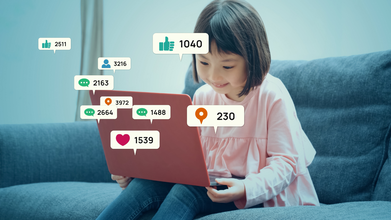- Health Conditions A-Z
- Health & Wellness
- Nutrition
- Fitness
- Health News
- Ayurveda
- Videos
- Medicine A-Z
- Parenting
Who Are 'Sandwich Carers'? Why Are Their Mental Health Declining?

Credits: Canva
Have you seen someone or felt like you have become sandwiched between two different responsibilities? You must have seen people who take care of their children and also their ageing parents? This is what we will be discussing today and how the burden of responsibility leads to a decline in their mental well-being.
What are Sandwich Carers?
The term "sandwich carers" refers to those who care for both their dependent children and elderly parents or relatives. They are "sandwiched" between two generations, managing the responsibilities of parenting and elder care. This condition is growing more common as people's life expectancy increases and they opt to have children later in life.
As per a UCL study supported by the UK Economic and Social Research Council, in UK alone it is estimated that around 1.3 million people are sandwich carers. While their role is vital for family well-being, the toll on their mental and physical health is significant. This new study by UCL researchers sheds light on the impact of this caregiving burden.
What the study says?
In order to understand how becoming a sandwich carer affects health, researchers analysed data from approximately 2,000 sandwich carers and 2,000 non-sandwich carers. They also used the information from the UK Household Longitudinal Study collected between 2009 to 2020.
The study analysed an average age of sandwich carers at 36.8 years, with the majority being adults between 30 to 49. This group was most likely to bear this dual caregiving responsibility, found the study.
Researchers monitored the participants’ mental and physical health during three phases: before, during, and after they became sandwich carers.
They used two primary tools for health assessment:
General Health Questionnaire (GHQ): This measured mental health by asking participants about issues like sleep disturbances, concentration problems, and stress.
Physical Component Summary (PCS): This evaluated physical health, including general health, mobility, and limitations caused by physical health problems.
What were the key findings?
The study found that their was a noticeable decline in mental health, impact on physical health, as well as the gender impacted on the caregiving hours.
Mental Health and its decline in sandwich carers: The study noted that people who were switching between taking care of their children and ageing parents, especially those who devote more than 20 hours each week to care saw a more severe impact. This degradation lasted several years, emphasizing the long-term mental burden of juggling two caregiving responsibilities.
Physical Health: Caregivers who worked more than 20 hours each week reported having lower physical health. This resulted in increasing physical discomfort, reduced mobility, and difficulty doing everyday duties.
Gender and Hour: The study found that, while both men and women were hurt, those who provided intense care suffered the most health issues.
Dr. Baowen Xue, who is the lead author of this study emphasized on the urgent need for societal recognition of the challenges faced by sandwich carers. “Our study highlights the significant mental and physical health challenges faced by sandwich carers. It's crucial that we recognise and support the unique needs of this growing group to ensure their health and resilience,” Dr. Xue stated.
Is India Next In Social Media Ban For Teens? After Australia And New York, Madras HC Asks Center To Look Into It

Credits: iStock
After Australia's social media ban for children under 16, New York is also considering a mental health warning for the young social media users. Social media platforms with infinite scrolling, auto play and algorithmic feeds will now be required to display warning labels about the harm to young users' mental health. This is under a new law, announced New York Governor Kathy Hochul.
“Keeping New Yorkers safe has been my top priority since taking office, and that includes protecting our kids from the potential harms of social media features that encourage excessive use,” Hochul said in a statement. This law aims to create a warning on platforms that offer "addictive feeds" auto play or infinite scrolls and applied to conduct occurring partly or wholly in New York. This however does not work for users when used outside the state. Hochul also compared the social media warning labels with products like tobacco, where there are labels like the risk of cancer on the packaging itself.
Not just this, but even India could be considering brining in a social media ban for teens.
What Is Happening In India With Teen Ban On Social Media?
While hearing a write petition, the Madras High Court asked the Union Government to look for possibilities in passing a legislation similar to the ban of under 16s using social media in Australia. The petition was to emphasize on the awareness of the stakeholders and parental windows in the device that could control the menace of pornographic material which is easily accessible to children. The court asked Centre to order internet provider service companies to provide a 'Parental Window' to prevent children from accessing such content.
The Madurai Bench of Justices G Jayachandran and KK Ramakrishnan told the authorities of child rights to accelerate this matter. The bench also noted that children could only be prevented from consuming such content only if there is a parental control app on the device. Judges also noted that parents have a higher responsibility in this, as children are highly vulnerable to such content.
What Is Happening In Australia?
To protect the mental health of children, Australia is now banning several social media apps, which include: Facebook, Instagram, Snapchat, Threads, TikTok, X, YouTube, Reddit, and streaming platforms Kick and Twitch. YouTube Kids, Google Classroom and WhatsApp are not covered under this rule as they do not fit those criteria. While anyone under 16 will be still able to watch most of the content without logging in, however, they cannot have an account on it. Critics are urging the government to widen the ban to include online gaming platforms such as Roblox and Discord, which are currently not covered.
Read: Australia Social Media Ban Explained: Why Government Plans to Restrict Accounts of Under-16s
The government says that it will also reduce the negative impact of social media's "design features that encourage [young people] to spend more time on screens, while also serving up content that can harm their health and wellbeing". A government study which was commissioned in 2025 found that 96% of children aged 10 to 15 used social media, and that seven out of 10 of them were exposed to harmful content. These content were misogynistic and violent in its nature, furthermore, content promoted eating disorders and suicide.
Children and parents will not be punished for infringing the ban, instead, social media companies will face fines of up to A$49.5m, which is equivalent of US$32m for serious or repeated breaches.
Australia Social Media Ban Explained: Why Government Plans to Restrict Accounts of Under-16s

Credits: iStock
Anyone below the age of 16 in Australia is now banned from using social media services. These platforms include TikTok, X, Facebook, Instagram, YouTube, Snapchat and Threads. The law now says that anyone under 16 cannot make new social media accounts and their existing accounts will be deactivated. This is the first of its kind banned and is also being watched by other countries.
What Is The Reason Behind The Under-16 Social Media Ban?
To protect the mental health of children is the main reason behind the ban. Furthermore, the government says that it will also reduce the negative impact of social media's "design features that encourage [young people] to spend more time on screens, while also serving up content that can harm their health and wellbeing". A government study which was commissioned in 2025 found that 96% of children aged 10 to 15 used social media, and that seven out of 10 of them were exposed to harmful content. These content were misogynistic and violent in its nature, furthermore, content promoted eating disorders and suicide.
Read: AI Therapy Gone Wrong: Psychiatrist Reveals How Chatbots Are Failing Vulnerable Teens
1 in 7 also reported experiencing grooming-type behavior from adults or older children. More than half said that they were also victim of cyberbullying. The ban right now expands over platforms and apps like Facebook, Instagram, Snapchat, Threads, TikTok, X, YouTube, Reddit, and streaming platforms Kick and Twitch.
The government laid down three categories, under which the ban has been considered for the apps, these criteria are:
- whether the platform’s primary or substantial purpose is to enable online social interaction between two or more users
- whether users can interact with some or all other users on the platform
- whether users are able to post or share content
YouTube Kids, Google Classroom and WhatsApp are not covered under this rule as they do not fit those criteria. While anyone under 16 will be still able to watch most of the content without logging in, however, they cannot have an account on it. Critics are urging the government to widen the ban to include online gaming platforms such as Roblox and Discord, which are currently not covered.
Also Read: Why Social Media Trends Could Be Detrimental To Your Health?
Are There Any Checks And Balances On The Ban?
The law notes that children and parents will not be punished for infringing the ban, instead, social media companies will face fines of up to A$49.5m, which is equivalent of US$32m for serious or repeated breaches. The government has said that these companies must take 'reasonable steps' to keep kids off the platforms. These 'reasonable steps' include asking for government IDs, face or voice, or "age interference" that analyzes online behavior and interactions to estimate a person's age. Platforms have been advised against relying on users self-certifying or parents vouching for their children. Meta, which own Facebook, Instagram and Threads have started to close teen accounts from December 4 onwards. Snapchat will also be using bank account, photo ID or selfies for verification.
However, government reports have found facial assessment technology to be least reliable for teenagers. Some critics have also raised their concerns on potential fines. Some have also pointed out other platforms which involves gaming platforms, or AI chatbots that have encouraged children to kill themselves and indulged in 'sensual' conversations with minors.
Zen Birth: Why Mothers Are Now Choosing This Over Delivery Rooms

Credits: iStock
For generations, childbirth has been closely tied to a certain visual and emotional script. Bright lights, clinical beds, beeping monitors, and an air of urgency have long defined labor rooms. Today, that script is being rewritten. Across hospitals and birthing centers, childbirth is undergoing a quiet but powerful aesthetic shift, one that places calm, comfort, and emotional safety at the center of the experience.
At the heart of this transformation is the growing popularity of warm water births and thoughtfully designed birthing spaces. As Dr. Preety Aggarwal, Medical Director of Obstetrics and Gynecology at Motherhood Hospitals, Gurugram explains, “From harsh hospital lights to calm, spa-like spaces, childbirth is being reimagined as a peaceful, deeply personal experience wherein tranquility takes center stage over tension.” What once felt intimidating is increasingly being shaped to feel intimate and reassuring.
From Medical Event to Life Experience
Childbirth has always been transformative, but for decades, the setting often heightened fear rather than eased it. Labor rooms were designed primarily for efficiency and medical control, not for emotional comfort. That approach is now evolving. More couples are actively seeking environments that respect birth as both a physiological and emotional journey.
“Childbirth is a one-of-a-kind experience. It is deeply transforming for the mother,” the doctor notes. This understanding has prompted hospitals to rethink how birthing spaces look and feel. Neutral colous, warm lighting, wooden textures, and minimal visual clutter are replacing stark whites and harsh fluorescents. The goal is not to eliminate medical safety, but to soften its visual dominance.
The rise of warm water birthing pools fits naturally into this shift. These pools are often placed in private, dimly lit rooms that resemble wellness studios rather than hospital wards. Gentle music, controlled lighting, and calming scents further enhance the sense of control and peace.
Why Warm Water Changes the Experience of Birth
Water has an innate ability to soothe. Immersion in warm water relaxes muscles, reduces physical tension, and encourages slower, deeper breathing. According to clinical observations, many women feel a stronger sense of control when laboring in water. The pool acts as a physical and psychological buffer, helping block out noise, distractions, and external stress.
The expert points out that water births are not only about comfort but also about reducing fear. Many mothers report feeling less anxious and more connected to their bodies during labor. This inward focus can make contractions feel more manageable and the overall experience more empowering.
Rephrasing this idea, the essence of water birth lies in its ability to support the body’s natural rhythm. Instead of fighting pain, women are encouraged to work with it, supported by warmth, buoyancy, and privacy.
Aesthetic Calm with Clinical Safety
One of the most common misconceptions about serene birthing environments is that they compromise safety. In reality, the shift is about balance. Modern birthing spaces are designed to keep medical equipment accessible but discreet. The focus is on emotional well-being alongside clinical readiness.
“There is a clear shift in attitude,” the doctor explains, adding that childbirth is no longer seen as just a medical event but as a life experience deserving emotional care. This change also reflects broader conversations around respectful maternity care, where the mother’s comfort, dignity, and choices are prioritized.
Creating a Zen Birth Experience
For expectant parents interested in this approach, preparation plays a key role. Choosing a hospital or birthing center that offers warm water birth options and calming room designs is the first step. Simple additions like soft lighting, calming music, and guided breathing techniques can make a noticeable difference.
Incorporating natural elements such as plants and warm colors helps create a grounding environment. Emotional support from a partner, doula, or trusted caregiver is equally important. A clear birth plan that balances comfort preferences with medical safety allows both parents and healthcare teams to work in harmony.
Redefining How Birth Feels
Warm water pools and serene birthing environments are changing more than the appearance of labor rooms. They are reshaping how birth is felt, remembered, and processed. By replacing tension with tranquility, this approach supports mothers in feeling calmer, more confident, and more present during one of life’s most intense moments.
As the expert advises, anyone considering this option should discuss it with their doctor and make informed decisions based on individual health needs. What is clear, however, is that the aesthetics of childbirth are no longer an afterthought. They are becoming an essential part of how birth itself is experienced, marking a meaningful shift toward gentler, more human-centered care.
© 2024 Bennett, Coleman & Company Limited

